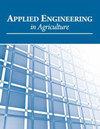Design and Field Test of a Low-cost Device for Real-time Livestock Tracking Using GPS/LoRa Communication
IF 0.8
4区 农林科学
Q4 AGRICULTURAL ENGINEERING
引用次数: 0
Abstract
Highlights Monitoring movement is crucial to improve livestock management. GPS livestock tracking method using LoRa with an effective medium access control mechanism. Adaptive data collection with near real-time monitoring. GPS data were collected for improving home-range management. Low implementation costs with increasing lifespan of the devices. Abstract. Extensive livestock grazing systems are in line with agroecological principles. However, these systems are particularly complex to manage. Developing accurate and reliable monitoring of livestock movements and activities is a promising tool to improve the global performances of these systems. Various livestock management systems have been developed over the past decades, culminating in sophisticated systems in intensive controlled environments that allow the real-time monitoring of movements, behaviors, health and production parameters for livestock individuals/herds (e.g. dairy cattle). However, extensive and semi-extensive systems for which the animals are ranging freely outdoors at least part of the time, are presenting specific challenges for combined tracking data acquisition and communication. In this article, we present a GPS livestock tracking method using LoRa communication with a new medium access control mechanism. The node lifespan and performance of the system were evaluated in real on-farm conditions in three different locations in Thailand and Vietnam. The results showed that our system performed adequately well in terms of position accuracy and timeliness. The accuracy of GPS data collected are compatible with their usage for improved rangeland management, monitoring livestock movements and impacts on the environment, and for back-tracking epidemiological movements and contacts of individuals/herds to control diseases outbreaks. The communication system via LoRa allowed to some extent real-time location of livestock herds by farmers due to instant position updates to the Internet, although the performance depended largely on the relief of the landscape surrounding the rangeland used. Finally, reducing costs and increasing the lifespan of the devices remain critical objectives to foster the adoption of such system by farmers and by certification groups to provide field-based evidence for the traceability and quality control of livestock and animal products raised under healthy and environmental-friendly productions systems. Our current design, if produced in a large quantity of at least 100 units, would cost approximately $65 USD per unit, with an average lifetime of 20 days. Keywords: Cattle, GPS, LoRa, Tracking system.基于GPS/LoRa通信的低成本牲畜实时跟踪装置的设计与现场测试
监测流动对改善牲畜管理至关重要。GPS家畜跟踪方法采用LoRa与有效的介质访问控制机制。具有近实时监控的自适应数据收集。收集GPS数据以改进家园范围管理。实现成本低,设备寿命长。摘要粗放型放牧系统符合农业生态原则。然而,这些系统管理起来特别复杂。发展对牲畜流动和活动的准确和可靠的监测是改善这些系统的全球绩效的一个有希望的工具。在过去的几十年里,各种牲畜管理系统得到了发展,最终形成了密集控制环境中的复杂系统,可以实时监测牲畜个体/畜群(如奶牛)的运动、行为、健康和生产参数。然而,动物至少部分时间在户外自由活动的粗放型和半粗放型系统对跟踪数据采集和通信的组合提出了具体的挑战。在本文中,我们提出了一种基于LoRa通信和一种新的媒体访问控制机制的GPS家畜跟踪方法。在泰国和越南三个不同地点的实际农场条件下,对系统的节点寿命和性能进行了评估。结果表明,该系统在定位精度和时效性方面表现良好。所收集的全球定位系统数据的准确性与其用于改善牧场管理、监测牲畜流动及其对环境的影响、回溯流行病学流动和个人/牛群接触以控制疾病暴发的用途是一致的。通过LoRa的通信系统在一定程度上允许农民实时定位畜群,因为互联网上的即时位置更新,尽管性能在很大程度上取决于所使用牧场周围景观的起伏。最后,降低成本和延长设备的使用寿命仍然是促进农民和认证团体采用这种系统的关键目标,以便为在健康和环境友好型生产系统下饲养的牲畜和动物产品的可追溯性和质量控制提供实地证据。我们目前的设计,如果大量生产至少100个单位,每个单位的成本约为65美元,平均寿命为20天。关键词:牛,GPS, LoRa,跟踪系统
本文章由计算机程序翻译,如有差异,请以英文原文为准。
求助全文
约1分钟内获得全文
求助全文
来源期刊

Applied Engineering in Agriculture
农林科学-农业工程
CiteScore
1.80
自引率
11.10%
发文量
69
审稿时长
6 months
期刊介绍:
This peer-reviewed journal publishes applications of engineering and technology research that address agricultural, food, and biological systems problems. Submissions must include results of practical experiences, tests, or trials presented in a manner and style that will allow easy adaptation by others; results of reviews or studies of installations or applications with substantially new or significant information not readily available in other refereed publications; or a description of successful methods of techniques of education, outreach, or technology transfer.
 求助内容:
求助内容: 应助结果提醒方式:
应助结果提醒方式:


